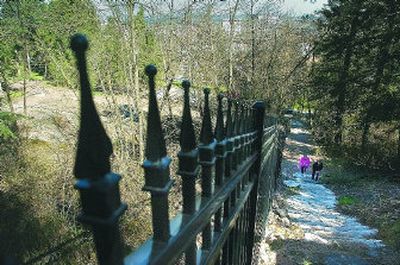Heritage site gets new start

A gift of more than $1 million by an elderly Spokane businesswoman has put the restoration of Spokane’s historic Moore-Turner Heritage Garden on a fast track, with opening expected by mid-August this year.
Workers for A.M. Landshaper Inc., of Spokane, are quickly transforming the previously overgrown hillside in Pioneer Park at Seventh Avenue and Stevens Street into a faithful replica of an extensive residential garden that once served a pioneer mansion there.
The job was made possible by a $1.2 million gift from Myrtle Woldson, a longtime neighbor to the garden.
Planting beds, pathways and garden structures are being installed in the same places they existed during the garden’s zenith in the early 1900s. Possibly the most dramatic feature is a large concrete duck pond and pergola on the upper reaches of the hillside. The pond’s original concrete basin is being reclaimed in the project, along with a few of the original stone pergola columns.
Lynn Mandyke, director of the adjoining Corbin Art Center and construction manager on the project, said the reopening of the garden will coincide with the 75th anniversary of the year that the garden began to fall into disrepair. During the latter half of the last century, its remains became covered in a tangle of underbrush and volunteer maples and conifers. The “ruins” were rediscovered in 1998 by Mandyke and others who wanted to clean up the forested hillside.
“After being untended for 75 years, the Moore-Turner garden will open to the public (this summer),” Mandyke said.
Starting in early May, workers will begin planting flowers, shrubs and trees to replicate the original look based on photographs and other records kept by the owners.
The garden was begun as part of the landscaping for an 1889 Kirtland Cutter-designed mansion built for F. Rockwood Moore, first president of the former Washington Water Power Co., now Avista.
When Moore died, the mansion was purchased by Judge George Turner and his wife, Bertha, who expanded the grounds with stonework and extensive plantings. They used it as a social gathering place. Turner, who had served a single term in the U.S. Senate, greeted President Teddy Roosevelt at the home in 1903 on a presidential swing through the West.
Bertha Turner moved away in 1932 after her husband died, and the garden began to decline. The mansion was torn down in 1940, a year after she died. Before her death, she donated photographs and other records to Washington State University.
Richard Hartlage, of Dietz/Hartlage Landscape Architecture, of Tacoma, said it appears that the garden was developed as part of Turner’s desire to further his political career and was used extensively in late spring and early summer and again in September and early October.
“I think she was using the garden from a social standpoint when the weather was comfortable,” Hartlage said during a visit to the site last week. “It was a platform for his political career.”
Because the garden extends upward along the slope of the lower South Hill, the plantings will stand out visually in a series of layers that should be pleasing to the eye, he said.
Many of the plants selected for the garden are old-fashioned perennials, roses and some annuals. Originally, a large number of the beds had annual flowers such as sweet William, ageratum, snapdragons and chrysanthemum.
A newer perennial cultivar of sweet William is being used in the planting plan because “they were incredibly popular at the time,” Hartlage said. In another example, an older iris with two tones of lavender and brownish purple was selected
“It’s very romantic,” Hartlage said of the garden. “What all of these plants are is a grandmother’s garden. There’s no doubt in my mind it’s going to be appealing.”
Both Mandyke and Hartlage predicted that the garden will become the top location in Spokane for outdoor weddings within a few years. “I think you are going to have fabulous wedding photographs here,” Mandyke said.
Only a few of the original plantings survived through the years of neglect, including a beaten and broken little leaf linden tree in one corner along an original staircase and mortared basalt stone wall. A few lilac bushes remain. Also, a dozen tulip bulbs were found and are being nursed back to strength in the hope that they may bloom once again.
Reconstruction of the garden began last year with earth work to re-create its original contour. The site apparently was used as fill for dirt from construction of Ben Garnett Way, Mandyke said.
Rock walls, stone pathway borders, irrigation and fencing also were installed in 2006.
The final phase of work this year is coming under a $561,000 contract with A.M. Landshaper. It includes reconstruction of a tea house, upper pergola and pond, rose arbor and carriage road. The work should be finished by mid-June and turned over to the Parks Department on July 1.
Much of the work was funded through Woldson’s gift in 2005 but also through several smaller grants and donations.